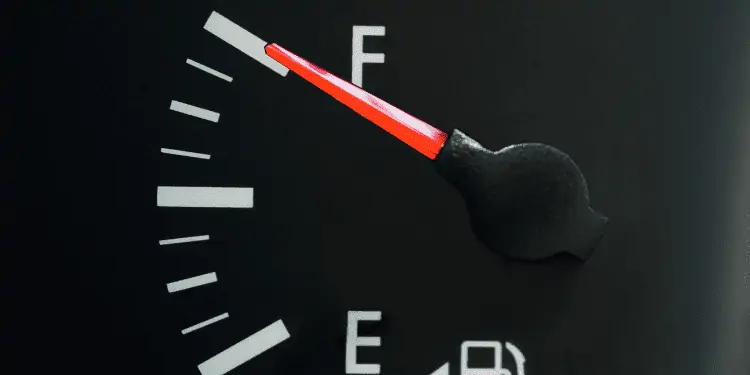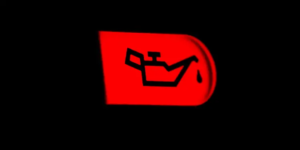Is it normal for your car to tilt and be lower on one side when parked or not?
If your car is lower on one side by an inch or less, you’ll hear no knocking noises, and it doesn’t bounce when you press down on the lower corner; everything is fine.
Bear with me on this. Often when a driver notices one wheel is lower than the others, it’s because the surface the car is parked on isn’t level.
On a hill will be fine, but if there is a slope between your car’s left and right side, it’ll alter the weight distribution making your car lean as one shock or spring will take more of the weight.
Ok, so we’ve got that out of the way. Now let’s look at all the causes.
1. Passenger Side Sits Lower Than Drivers Side By Design
Many cars are designed to be slightly lower on one corner than the other.
The idea is that when a driver of average weight sits in the driver’s seat, it will reduce the height gap between the wheel and the bodywork. Therefore righting the difference. The corner with a full fuel tank may be slightly tilted too.

Some car manufacturers have a 55/ 45 distribution to allow a driver and a full fuel tank.
Unfortunately, there isn’t readily available data from car manufacturers to show this. It’s commonly accepted, especially in sports cars requiring precision handling.
2. Factory Camber Settings
Have you changed your suspension recently? If not, feel free to move on to number three below.
If you’ve recently changed your springs yourself, it could have messed with the factory camber settings if your car’s manufacturer stipulated some – not all do.
A car shop is likely to have the settings for aligning cars, but they’re generally unavailable to the public.
That being said, it’s still unlikely that the weight would be distributed on one wheel more than the others, even if the camber settings were messed with. Therefore a tilt or lean because of factory camber settings is unlikely.
Generally, all four wheels would still sit at the same height away from the car bodywork.
3. E Brake or Park Brake Sticking
Most cars use the rear wheels to engage the e-brake or the parking brake. If you notice both rear wheels or lower than the front, it could be the parking brake.

You’ll likely have encountered other issues with your parking brake, such as rolling in Park, for this to be at fault. Still, if you’re parked on a level surface, your springs are in good condition, and you haven’t changed any suspension parts before noticing the difference, it could be a parking brake issue.
Air Suspensions and Leaning to One Side
Many cars have air suspension as standard now. Mercedes, Range Rover, Audi, Jeep, and Volvo have put them into higher-end models.
If your car is leaning to one side with air suspension, try lowering it all the way and then back up to the normal setting.
That will often reset it, but if not, it’s time to get your car to the dealer. It’s generally too complicated to sort it out by yourself at home.
Many parts are involved in the air suspension, including sensors, compressors, and struts. Trying to remedy this by yourself could result in causing more damage to the system resulting in a large repair.
Many car shops won’t touch air suspension and will redirect the driver to the dealer instead.
Common Signs of A Bad Spring and Shock
One corner being lower when parked is more of a sign of a spring failure. To test, ensure you have enough air in each tire and the pressure is the same on all four.
The Corner Bounces When Pushed Down
Next, press down on the bodywork on the lower-leaning corner. Does it spring back straight away, or does it bounce a few times? If it bounces, it is a sign that your spring and shock is bad.
Knocking Noises
You may also have heard knocking noises on uneven roads or if you drive over a pothole. It will only last for the short time that your wheel is in the hole and stop when you get back on an even road again.
Vehicle Dives When Braking
If the front side of your car tilts forward – gets lower – when you hit the brakes, this indicates that the spring on that side needs replacing.
How Long Do Springs Last?
Springs can last the vehicle’s lifetime, especially if most of its driving has been on good roads. If the car has been driven off-road all on gravel for most of its life, the springs will fail a quicker.
Springs aren’t replaced during routine maintenance.
Driver Side Sits Lower Than Passenger
It’s quite unusual for a driver’s side to sit lower than a passenger’s when parked but it can be by design. especially if you have a car that is manufactured outside the US.
Many of our favorite cars come from Japan and Japan has left-hand drive cars.
Now of course the driver’s seat and controls are altered before being imported into the US market but other major differences will still be there.
One big consideration is what side the fuel tank is on. Many larger SUVs can take 100 l of fuel, if the tank is on the driver’s side it will cause this side to sag slightly more than the passenger.
It could also be that the suspension on the driver’s side is more worn than on the passenger especially if the car doesn’t normally have passengers in the passenger seat in the front.
This will be a very gradual change but over time it will cause one area of the suspension to wear more than the other.
In Conclusion
A car leaning to one side has faults with the chassis, suspension, shocks, coil springs, or struts. None of these auto parts should be ignored because they are all essential.
Further deterioration to these systems can be made by continuing to drive a car tilted to one side or the other.
Many cars naturally sit lower on one side when parked; it’s how they have been set up at the factory. If your car is lower by more than an inch and makes noises, the spring may be bad and need replacing.
If there is no noise and the car sits less than 1 inch lower than on the other side, there is nothing to worry about. Often allowances are made for the weight of fuel in a fuel tank and the weight of a driver in the cabin.
Often tilting or leaning to one side indicates a bad coil spring and that the suspension has dropped to one side.
If you have upgraded the suspension, it’s possible it wasn’t adjusted correctly and needs further realigning.







![Car Wobbles At Low Speeds - [Troubleshooter Guide] inflating-tire-on-balancing-machine](https://carzaza.com/wp-content/uploads/2023/12/inflating-tire-on-balancing-machine-300x150.png)





